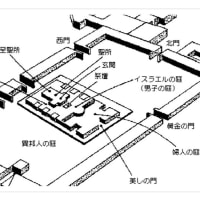47章 いのちの水の川と新しい相続地
1.命の水の川
47-48章は、新しい神殿を中心としたイスラエルの相続地について語っています。重要なのは、前半に書かれた神殿の敷居の下から東の方へと流れ出るいのちの水と、後半に書かれた相続地の境界についての説明です。
まず水は、どんどん水量が増し(3-5節)、アラバに下り、死海に入ります(8節)。アラバは、ヨルダン川が死海に入る地域を指していますが、本来この地域は、雨期を除いてほとんど水利がなく、乾燥しています。また、死海は、水の出口がありませんから、その水は乾燥と共に濃縮され、塩分の濃い水となり、生き物が生息することのできない、塩の海です。しかし、神殿から流れるその水は、死の海をいのちの海に変える力を持つのです。また、その水が流れる土地は、作物を豊かに実らせます(12節)。それは、実際にはあり得ない状況です。
となるとこの幻は、終末的な内容、つまり、新約聖書のヨハネの黙示録が語っている幻に通じる内容があるのではないでしょうか。ヨハネは言いました。「御使いはまた、水晶のように輝く、いちの水の川を私に見せた。川は神と小羊の御座から出て、都の大通りの中央を流れていた」(黙示録22:1、2)。こうしてエゼキエルの最後の幻は、ヨハネの幻が語る内容と重なっており、象徴的に終末的状況を語っていると考えられるのです。
しかし、エゼキエルがこの書を書いた時の読者、つまり当時のユダヤ人は、そのようには読まなかったはずです。彼らは、これらを同じように象徴的に受け止めながら、捕囚帰還後のエルサレムの回復を豊かに思い描いたはずなのです。つまり、エゼキエルは、捕囚先のバビロンにて、ユーフラテスの豊かな水の流れを見ながら、荒れ果て、乾いた都エルサレムの回復されたイメージを語っている。しかし、その都は、全く新しい都ではなく、古い塩の海のイメージを引きずっています。死海は死海として残るわけです。ただ、エルサレムの回復は素晴らしいものがある、それは実に豊か!そのように回復させる神を見よ!いのちの源である神を仰げ!というのがこの箇所に込められたメッセージでしょう。ヨハネは、このエゼキエルのメッセージを踏まえて、イエスは、さらに素晴らしい恵みを約束された、それは新天新地で、エゼキエルが語った死の海をいのちの海に変えることが起こる、そのような恵みだと語ったと言えるのです。私たちが信じる神は、天地創造の神であり、死をいのちに、闇を光に変える神なのです(ヨハネ7:37,38)。
2.土地の割り当て
次に後半の13節からは、回復された土地の割り当てについて説明されます。不思議です、バビロンにいたエゼキエルは、その版図をメソポタミアにまで伸ばすこともできたことでしょう。しかし神の都を示すその版図は、大ぶろしきに拡大されることもなく、オリジナルのイスラエルの区域に限定されていました。つまり、大雑把に言えば、北側は地中海(「大海」15節)沿いのツロから、ダマスコの南西あたりまで(15-17節)。そして南側は、死海の少し南から、エジプトの川の河口と地中海に至るライン(19節)。西側は地中海(20節)、東側はヨルダン川と死海(18節)です。この地をイスラエルの部族ごとに割り当てる、と言うのです。それは完全に古代イスラエルの回復だけを語るものです。
ただ、そこに集められる住民に注目されます。そこには生粋のイスラエル人だけではなく、改宗した在留異国人も受け入れられています(22-23節)。もはや、新しいイスラエルは、血肉のイスラエルの枠を超えているのです。明らかにそれは捕囚期以前とは違う、他民族多文化的な国家のイメージを伝えています。もはや、肌の色、血筋、ことば、生まれの違いは問題にされず、ただ、いのちの源である神を信じる信仰、そこに一致した者が集められるのです。ルツが継母のナオミの信仰に応答し、唯一まことの神を、我が神、我が主として認めた、そのつながりが全てなのです(ルツ1:16)。そうすれば、「寄留者」と見なされる者もその地を相続できると言います(23節)。つまり、主を信じる者は皆一つの家族であり、自分の分を祝福として受けるのです。ヨハネの黙示録においては、もはやこの地上の地理的境界は問題ではありません。それは新天新地なのです。ただ、そこに所属する者とそうでない者のリミットがあることは確かです。そして、そこに所属する者は、唯一まことの神を、我が神、我が主として認めることは同じです。終末においては一つの家族として祝福を受けるイメージの原型がここにあります。終末の主の恵みに期待を持って今日も歩みましょう。では今日も良き一日となるように祈ります。
<クイズコーナー>
最初に、昨日のクイズです。イスラエルの安息は、いつから始まり、いつから終わるものでしょうか?①金曜日の朝開けから日没まで。②金曜日の日没から土曜日の日没まで。③土曜日の朝開けから土曜日の日没まで。答えは②金曜日の日没から土曜日の日没まででした。では、今日の聖書クイズです。死海の塩分の含有量は、何パーセントとされているでしょうか?①15%、②30%、③50%。答えは、また明日。では今日も良き一日となるように祈ります。
Chapter 47: The River of Water of Life and the New Inheritance
1. the river of the water of life
Chapters 47-48 speak of Israel's inheritance land centered on the new temple. Of importance is the description in the first half of the chapter of the waters of life flowing out from under the threshold of the temple toward the east, and the description in the second half of the chapter of the boundaries of the inheritance land.
First, the waters flow in ever-increasing volumes (vv. 3-5), descending to the Arabah and entering the Dead Sea (v. 8). The Arabah refers to the area where the Jordan River enters the Dead Sea, which is essentially dry, with little water availability except during the rainy season. The Dead Sea has no outlet, so the water concentrates as it dries and becomes salty, making it a salty sea where no living creature can live. However, the water flowing from the temple has the power to transform the sea of death into a sea of life. And the land through which the waters flow produces crops in abundance (v. 12). This is an impossible situation.
Then, this vision must have an apocalyptic content, which is similar to the vision spoken of in the New Testament book of Revelation. John said. The angel also showed me a river of water, shining like crystal. The river came from the throne of God and of the Lamb, and flowed through the middle of the main street of the city" (Revelation 22:1, 2). Thus, Ezekiel's final vision overlaps with what John's vision tells us, symbolically speaking of an apocalyptic situation.
However, Ezekiel's readers at the time he wrote the book, i.e., the Jews of the time, would not have read them that way. They would have received them in the same symbolic way, but would have envisioned the restoration of Jerusalem after the return of the captives in abundance. In other words, Ezekiel is speaking of a restored image of the desolate and parched city of Jerusalem in Babylon, where the captivity took place, with the rich waters of the Euphrates flowing through it. But the city is not an entirely new city; it drags with it the image of the old salt sea. So the Dead Sea remains as the Dead Sea. But there is something wonderful about the restoration of Jerusalem, it is rich indeed! Behold God who restores it that way! Look to God, the source of life! That is the message of this passage. Based on Ezekiel's message, John could say that Jesus promised even more wonderful grace, the kind of grace that will transform the sea of death into the sea of life that Ezekiel spoke of in the new heaven and new earth. The God we believe in is the God of creation, the God who transforms death into life and darkness into light (John 7:37, 38).
2. allotment of land
The second half of the passage, beginning in verse 13, then describes the allotment of the restored land. It is curious that Ezekiel, who was in Babylon, could have extended his land all the way to Mesopotamia. But his version of the city of God was limited to the original area of Israel, without being expanded into the greater scheme of things. That is, roughly speaking, from Tyro along the Mediterranean Sea ("the Great Sea," v. 15) in the north to about southwest of Damascus (vv. 15-17). And the south side is a line from a little south of the Dead Sea to the mouth of the river of Egypt and the Mediterranean Sea (v. 19). To the west is the Mediterranean Sea (v. 20), and to the east is the Jordan River and the Dead Sea (v. 18). It says that this land will be allotted to each of the tribes of Israel. It speaks completely only of the restoration of ancient Israel.
However, attention is drawn to the inhabitants who will be gathered there. Not only native Israelites but also converted resident aliens are accepted there (vv. 22-23). The new Israel is no longer Israel of flesh and blood. Clearly it conveys an image of a different, other-ethnic, multicultural nation than it was before the captivity. No longer are differences of color, lineage, language, or birth a problem; only faith in God, the source of life, and those who are united in that faith are gathered. It is all about that connection where Lutz responds to the faith of his stepmother Naomi and acknowledges the one true God as my God and my Lord (Lutz 1:16). Then, he says, even those who are considered "sojourners" can inherit the land (v. 23). In other words, all who believe in the Lord are one family and receive their portion as a blessing. In Revelation, the geographical boundaries of the earth are no longer an issue. It is a new heaven and a new earth. But it is certain that there is a limit to who belongs there and who does not. And those who belong there are the same in that they acknowledge the one true God as my God and my Lord. Here is the archetype of the image of being blessed as one family at the end of time. Let us walk today with expectation for the grace of the Lord at the end of time. I pray that today will be another good day.
<Quiz Corner </div>
First, yesterday's quiz. When did the Sabbath of Israel begin and end? (1) From Friday morning opening until sunset. (2) From Friday sunset to Saturday sunset. (iii) From the opening of Saturday morning to Saturday sunset. The answer was (2) from Friday sunset to Saturday sunset. Now for today's Bible quiz. What is the salt content of the Dead Sea considered to be? (1) 15%, (2) 30%, and (3) 50%. The answer will be given tomorrow. Well, I wish you a good day today.
















